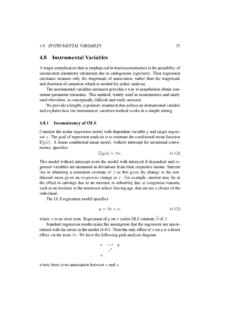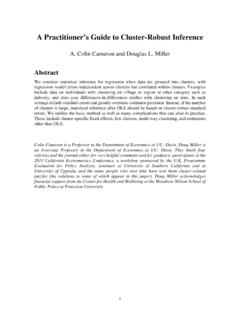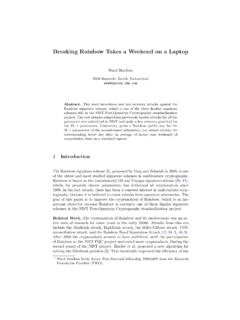Transcription of Microeconometrics Using Stata - University of California ...
1 Microeconometrics Using Stata Second Edition DRAFT TO Stata PRESS FOR PRODUCTION. NOVEMBER 2020. A. COLIN CAMERON. Department of Economics University of California , Davis, CA. and School of Economics University of Sydney, Sydney, Australia PRAVIN K. TRIVEDI. School of Economics University of Queensland, Brisbane, Australia and Department of Economics Indiana University , Bloomington, IN. A Stata Press Publication StataCorp LP. College Station, Texas Contents List of tables xvii List of figures xix Preface to the Second Edition xxiii Preface to the First Edition xxv 1 Stata basics 1. Interactive use .. 1. Documentation .. 2. Command syntax and operators .. 5. Do-files and log files .. 13. Scalars and matrices .. 17. Using results from Stata commands .. 18. Global and local macros .. 21. Looping commands .. 24. Mata and Python in Stata .
2 27. Some useful commands .. 27. Template do-file .. 27. Community-contributed commands .. 28. Additional resources .. 29. Exercises .. 29. 2 Data management and graphics 31. Introduction .. 31. Types of data .. 31. Inputting data .. 34. Data management .. 41. iv Contents Manipulating datasets .. 57. Graphical display of data .. 64. Additional resources .. 77. Exercises .. 78. 3 Linear regression basics 81. Introduction .. 81. Data and data summary .. 81. Transformation of data before regression .. 89. Linear regression .. 91. Basic regression analysis .. 97. Specification analysis .. 114. Specification tests .. 123. Sampling weights .. 131. OLS Using Mata .. 135. Additional resources .. 137. Exercises .. 137. 4 Linear regression extensions 139. Introduction .. 139. In-sample prediction .. 139. Out-of-sample prediction .. 147.
3 Predictive margins .. 150. Marginal effects .. 163. Regression decomposition analysis .. 173. Shapley decomposition of relative regressor importance .. 180. Differences-in-differences estimators .. 181. Additional resources .. 188. Exercises .. 188. 5 Simulation 191. Introduction .. 191. Pseudorandom-number generators .. 192. Contents v Distribution of the sample mean .. 198. Pseudorandom-number generators: Further details .. 203. Computing integrals .. 210. Simulation for regression: Introduction .. 215. Additional resources .. 225. Exercises .. 225. 6 Linear regression with correlated errors 227. Introduction .. 227. GLS and FGLS regression .. 228. Modeling heteroskedastic data .. 232. OLS for clustered data .. 238. FGLS estimators for clustered data .. 246. Fixed effects estimator for clustered data .. 250. Linear mixed models for clustered data.
4 257. Systems of linear regressions .. 265. Survey data: weighting, clustering, and stratification .. 273. Additional resources .. 279. Exercises .. 280. 7 Linear instrumental variables regression 283. Introduction .. 283. Simultaneous equations model .. 284. IV estimation .. 288. IV example .. 294. Weak instruments .. 307. Diagnostics and tests for weak instruments .. 316. Inference with weak instruments .. 329. Finite sample inference with weak instruments .. 337. Other estimators .. 338. 3 SLS systems estimation .. 342. Additional resources .. 343. vi Contents Exercises .. 344. 8 Linear panel-data models: basics 347. Introduction .. 347. Panel-data methods overview .. 347. Summary of panel-data .. 352. Pooled or population-averaged estimators .. 366. FE or within estimator .. 369. Between estimator .. 374. RE estimator .. 375.
5 Comparison of estimators .. 378. First-difference estimator .. 384. Panel-data management .. 386. Additional resources .. 390. Exercises .. 390. 9 Linear panel-data models: extensions 393. Introduction .. 393. Panel IV estimation .. 393. Hausman Taylor estimator .. 396. Arellano Bond estimator .. 399. Long panels .. 414. Additional resources .. 424. Exercises .. 424. 10 Introduction to nonlinear regression 427. Introduction .. 427. Binary outcome models .. 427. Probit model .. 430. Marginal effects .. 433. Logit model .. 439. Nonlinear least squares .. 440. Other nonlinear estimators .. 442. Contents vii Additional resources .. 443. Exercises .. 443. 11 Tests of hypotheses and model specification 445. Introduction .. 445. Critical values and p-values .. 446. Wald tests and confidence intervals .. 450. Likelihood-ratio tests.
6 463. Lagrange multiplier test (or score test) .. 467. Multiple Testing .. 470. Test size and power .. 477. The power commands for multiple regression .. 483. Specification tests .. 493. Permutation tests and randomization tests .. 495. Additional resources .. 497. Exercises .. 497. 12 Bootstrap methods 499. Introduction .. 499. Bootstrap methods .. 499. Bootstrap pairs Using the vce(bootstrap) option .. 501. Bootstrap pairs Using the bootstrap command .. 508. Percentile-t bootstraps with asymptotic refinement .. 516. Wild bootstrap with asymptotic refinement .. 520. Bootstrap pairs Using bsample and simulate .. 529. Alternative resampling schemes .. 530. The jackknife .. 535. Additional resources .. 536. Exercises .. 537. 13 Nonlinear regression methods 539. Introduction .. 539. Nonlinear example: doctor visits .. 539. viii Contents Nonlinear regression methods.
7 542. Different estimates of the VCE .. 555. Prediction .. 562. Predictive margins .. 567. Marginal effects .. 570. Model diagnostics .. 585. Clustered data .. 589. Additional resources .. 595. Exercises .. 596. 14 Flexible regression: finite mixtures and nonparametric 599. Introduction .. 599. Models based on finite mixtures .. 600. FMM example: Earnings of doctors .. 606. Global polynomials .. 618. Regression splines .. 621. Nonparametric regression .. 627. Partially parametric regression .. 632. Additional resources .. 633. Exercises .. 633. 15 Quantile regression 635. Introduction .. 635. Conditional quantile regression .. 636. Conditional QR for medical expenditures data .. 639. Conditional QR for generated heteroskedastic data .. 651. Quantile treatment effects for a binary treatment .. 654. Additional resources .. 657. Exercises.
8 657. 16 Nonlinear optimization methods 661. Introduction .. 661. Newton Raphson method .. 661. Contents ix Gradient methods .. 666. Overview of ml, moptimize and optimize commands .. 670. The ml command: lf method .. 672. Checking the program .. 678. The ml command: lf0-lf2, d0-d2 and gf0 methods .. 684. Nonlinear IV (GMM) example .. 691. Additional resources .. 694. Exercises .. 694. 17 Binary outcome models 697. Introduction .. 697. Some parametric models .. 697. Estimation .. 700. Example .. 702. Goodness of fit and prediction .. 708. Marginal effects .. 715. Clustered data .. 718. Additional models .. 719. Endogenous regressors .. 724. Grouped and aggregate data .. 732. Additional resources .. 735. Exercises .. 735. 18 Multinomial models 737. Introduction .. 737. Multinomial models overview .. 737. Multinomial example: choice of fishing mode.
9 741. Multinomial logit model .. 744. Alternative-specific conditional logit model .. 749. Nested logit model .. 757. Multinomial probit model .. 763. Alternative-specific random-parameters logit .. 768. x Contents Ordered outcome models .. 771. Clustered data .. 775. Multivariate outcomes .. 776. Additional resources .. 779. Exercises .. 780. 19 Tobit and selection models 781. Introduction .. 781. Tobit model .. 782. Tobit model example .. 784. Tobit for lognormal data .. 793. Two-part model in logs .. 801. Selection models .. 804. Non-normal models of selection .. 811. Prediction from models with outcome in logs .. 815. Endogenous regressors .. 818. Missing data .. 819. Panel attrition .. 824. Additional resources .. 845. Exercises .. 845. 20 Count-data models 847. Introduction .. 847. Modeling strategies for count data .. 848.
10 Poisson and negative binomial models .. 852. Hurdle model .. 867. Finite-mixture models .. 873. Zero-inflated models .. 891. Endogenous regressors .. 899. Clustered data .. 908. QR for count data .. 910. Additional resources .. 915. Contents xi Exercises .. 916. 21 Survival analysis for duration data 919. Introduction .. 919. Data and data summary .. 920. Survivor and hazard functions .. 924. Semiparametric regression model .. 929. Fully parametric regression models .. 937. Multiple-records data .. 947. Discrete-time hazards logit model .. 949. Time-varying regressors .. 953. Clustered data .. 953. Additional resources .. 954. Exercises .. 954. 22 Nonlinear panel models 957. Introduction .. 957. Nonlinear panel-data overview .. 957. Nonlinear panel-data example .. 962. Binary outcome and ordered outcome models .. 965. Tobit and interval-data models.




